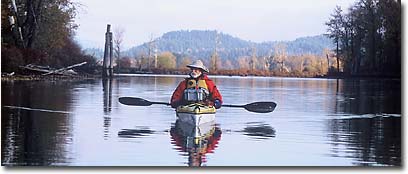Outfitting Your Touring Kayak
For a day paddle around the local pond or near shore in a lake or bay, you may get by with the boat, a paddle, some appropriate clothing and a good PFD. For safety's sake, and if you’re going to venture away from shore and perhaps do overnight trips, here’s some additional gear you should consider.

Safety Gear
For self-rescue, a paddle float is very important. It’s an inflatable “pillow” that is slipped over your paddle blade and serves as an outrigger to assist you in re-entering your boat in open water.
Kayaks sit low in the water, so it’s important for your safety that you be seen by other boaters, especially power boaters. Reflective tape and/or piping is a good feature on touring PFDs. In reduced visibility conditions, like in fog or when paddling at night, a battery-powered strobe light that straps to you or your boat can be a lifesaver. For maximum 360° visibility, put one of the lights on the bow of your boat and one on the stern.
To signal other boaters, carry a loud whistle in a readily accessible place, for example clipped to your PFD. Select one that doesn’t use a “pea” (the little cork ball inside some types of whistles). In a water environment, the pea can cause the whistle to malfunction. Another important signaling device is the signal mirror, a mirror with a sighting hole in the center that facilitates aiming the sun’s reflection at search aircraft or other distant observers.
You should also have an easily accessible knife. Some paddlers choose a sheath knife that’s clipped to the lash tab of their PFD. Others prefer a folding knife that they can keep in a pocket in their PFD or paddling jacket. The important thing is to have it readily available while you’re paddling. If you sliced the salami at lunch and left it in the food bag, it won’t do you any good in an emergency.
A paddle leash can prevent loss of your paddle during a wet exit. Taking a spare paddle is also a good idea, especially when you’re on a longer trip. A tow rope system is a good thing to have along for rescuing a boat or assisting a tired paddler. A portable marine VHF radio is a great accessory for open water boating; it will allow you to communicate with other boats, get weatheradio broadcasts and summon rescue services. Protect your radio with some type of waterproof housing.
Sprayskirts
Unless you’re doing some pretty limited paddling, you really need a sprayskirt. It seals around the cockpit rim and your waist to keep water out of the boat. Touring skirts fall roughly into two categories: they are either made from a waterproof fabric or from fabric-covered neoprene.
The fabric sprayskirts can come in breathable or non-breathable material and will have an adjustable bungee cord rand (the part of the skirt that secures it under the cockpit rim) and an adjustable waist closure. Some features to look for are pockets and hand-warmer pouches in the tunnel, suspenders (usually removable) and daisy-chain loops (for clipping on accessories). Implosion bars are stiffeners in the front portions of fabric skirt decks to prevent water pooling.
Neoprene skirts have a non-adjustable rand and must be more closely sized to the cockpit. They may have a fitted neoprene tunnel or an adjustable fabric one. The fabric tunnels may have pockets, hand warmers and suspenders.
Neoprene skirts are generally more watertight and often chosen by boaters that plan to learn to roll their kayak. Breathable fabric skirts can be more comfortable in warm weather. Choose the skirt that works best for your type of paddling. You may find that you need more than one skirt to fit all your paddling styles.
Navigation
For open water navigation you will need a compass, preferably one mounted right there on the deck in front of you. GPS units are very affordable and are excellent navigation aids; be sure to protect them with some type of waterproof enclosure.
Other Accessories
Even with a sprayskirt, you’ll get some water in the boat. You’ll need a bilge pump for larger amounts of water and a sponge for the smaller jobs.
Some type of deck storage is good for keeping items such as your bilge pump, water bottle and paddle float close at hand. If your boat doesn’t have deck rigging, you can retrofit it with some tie down brackets and bungee cord and/or prusik cord. A deck bag can corral and contain multiple items for you.
It’s a good idea to put together a repair/emergency kit that you carry in your boat at all times. It should include such items as duct tape (get the good stuff), a hank of lightweight rope, some light tie wire, Swiss army knife or multi-tool, some toilet paper, small hand trowel, needle and thread, head lamp w/ spare batteries, a lighter and some fire starter, small medical kit, signal mirror, emergency “space” blanket or bivvy sack, water purification tablets, some energy bars and any repair materials for your specific gear. All this can be packed into a small dry bag and will help you through most emergency situations.
(Please note that we’ve put together a package of several of the important safety items in the Deluxe Touring Safety Kit. You get a bilge pump, whistle, signal mirror, paddle float, paddle leash and sponge, all of which is packaged in our Mesh Deck Bag.)
 NRS Gift Card: Always Fits, Always Wanted
NRS Gift Card: Always Fits, Always Wanted




